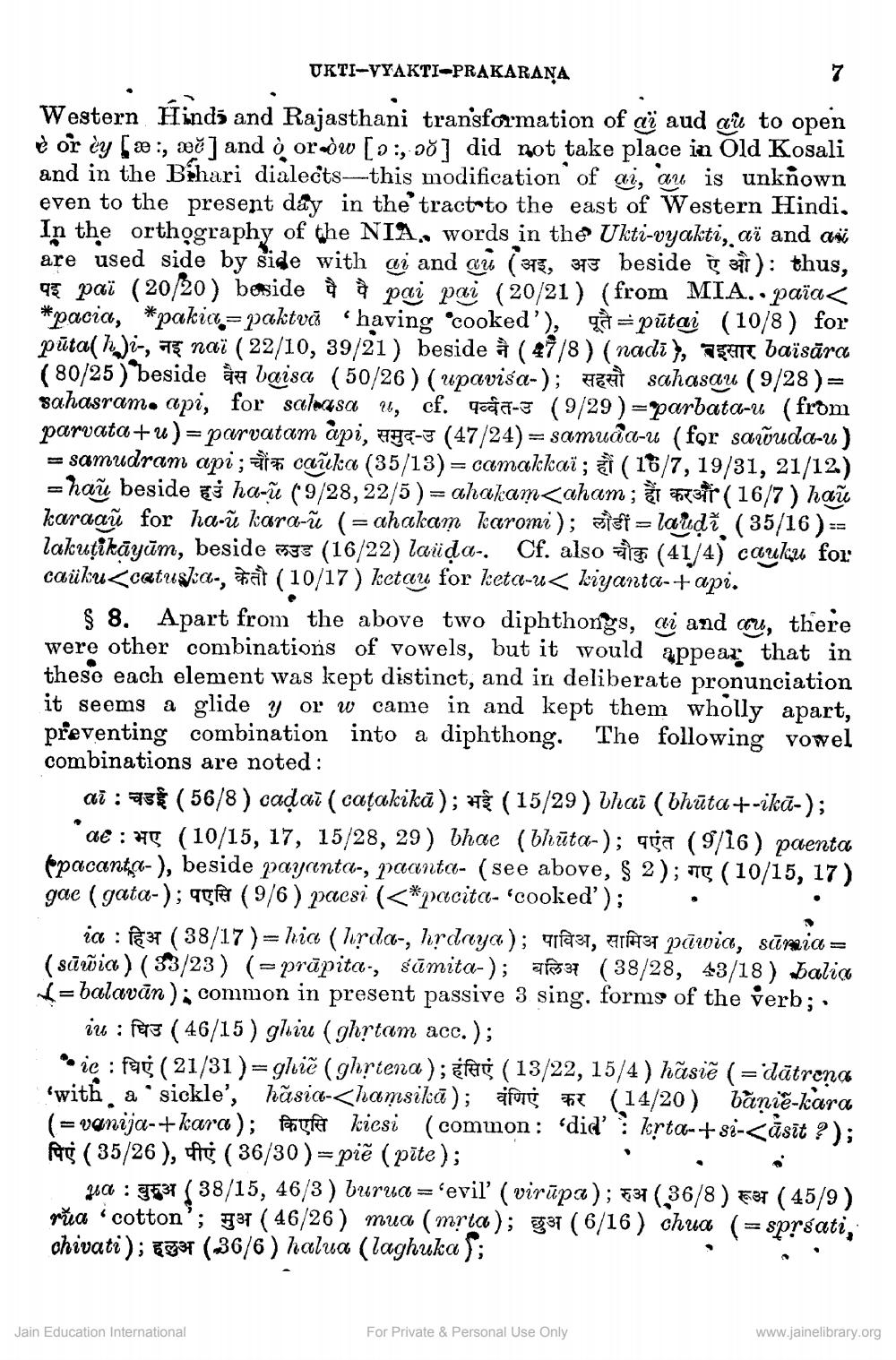________________
UKTI-VYAKTI-PRAKARANA
Western Hindi and Rajasthani transformation of ar aud au to open è or èy fæi, æč] and ò ordw [ɔ:, ] did not take place in Old Kosali and in the Bihari dialects-this modification of ai, au is unknown even to the present day in the tract-to the east of Western Hindi, In the orthography of the NIA, words in the Ukti-vyakti, aï and ai are used side by side with ai and a (अइ, अउ beside ऐ औ): thus, 9 paï (20/20 ) beside do pai pai (20/21) (from MIA.. paža< *pacia, *pakia=paktvá "having 'cooked'), ge=pūtai (10/8) for pūta( 7.)i-, 75 naï (22/10, 39/21 ) beside # ( 47/8) (nadi), gan baïsāra (80/25) beside ag baisa (50/26) (upavisa-); petit sahasau (9/28 )= sahasram. api, for salwasal, cf. googa-s (9/29 ) =parbata-u (from parvata+u)= parvatam api, ay-u (47/24)= samuốa-u (for sarõuda-u) - samudram api ; ## cañka (35/13) = camakkaï ; i (16/7, 19/31, 21/12) = haŭ beside i ha-(9/28, 22/5)= ahakam<aham; et par str (16/7) hał karaañ for ha-ũ kara-ữ ( = ahakam karomi); ziet = laidi (35/16 ) == lakuţikāyām, beside 753 (16/22) laüda-. Cf. also dis (41/4) cauku for: caüku<catusta., Fat (10/17) ketau for keta-u< kiyanta-+api.
§ 8. Apart from the above two diphthongs, ai and cu, there were other combinations of vowels, but it would appear that in these each element was kept distinct, and in deliberate pronunciation it seems a glide y or w came in and kept them wholly apart, preventing combination into a diphthong. The following vowel combinations are noted:
ai : 436 (56/8) caļai ( cațakikā); H (15/29) Thai (bhūta+-ikā-); *ae : 9 (10/15, 17, 15/28, 29) bhae (bhūta-); qga (9/16) paenta (pacanta-), beside payanta-, paanta- (see above, $ 2); T (10/15, 17) gae (gata-); agrer (9/6) pacsi (<*pacita- 'cooked'); .
ia : 37 (38/17 )=hia (hırda-, hrdnya); quêet, art pāwia, sūmia= (sūwia) (33/23) (= prūpita, sūmita-); afs3 (38/28, 43/18) balia *=balavān); common in present passive 3 sing. forms of the verb;
iu : fers (46/15 ) ghiu (ghrtam acc.); "ic:faj (21/31 )=ghič (ghrtena); etag (13/22, 15/4) hảsič ( = dātrena 'with a sickle', hãsia-<hamsikā); sifon ** (14/20) bàņie-kara (=vanija-+kara); mye kicsi (common: did': krta-+si-<ăsīt ?); Ag ( 35/26 ), fig ( 36/30 )= pię (pite);
2a : 9537 (38/15, 46/3 ) burua=evil (virūpa); +31 (36/8) FST ( 45/9) răna • cotton”; gai ( 46/26) mua ( mua ); $1 ( 6/16) chua (= spreati, chivati); (36/6 ) halua (laghuka);
Jain Education International
For Private & Personal Use Only
www.jainelibrary.org




